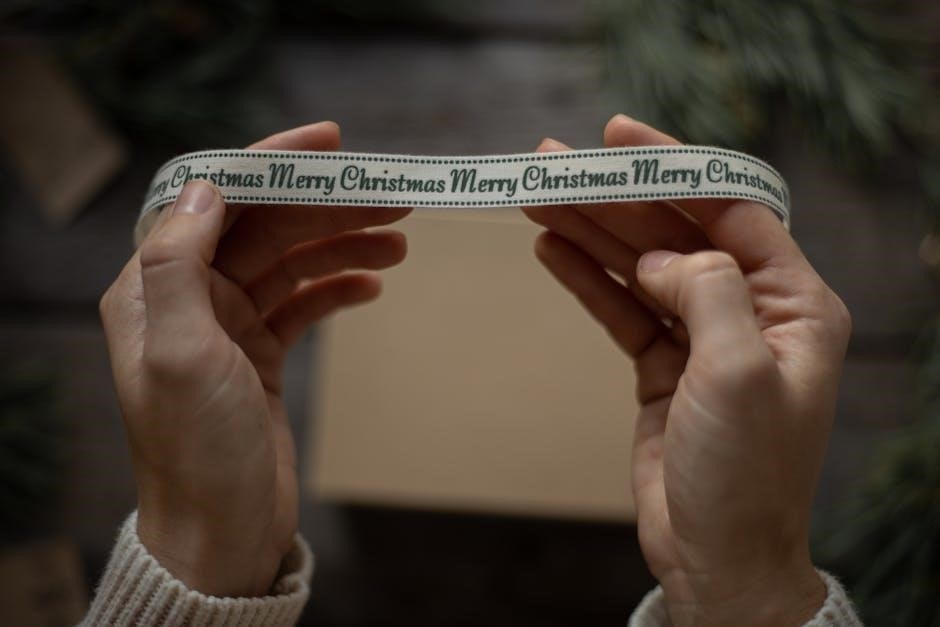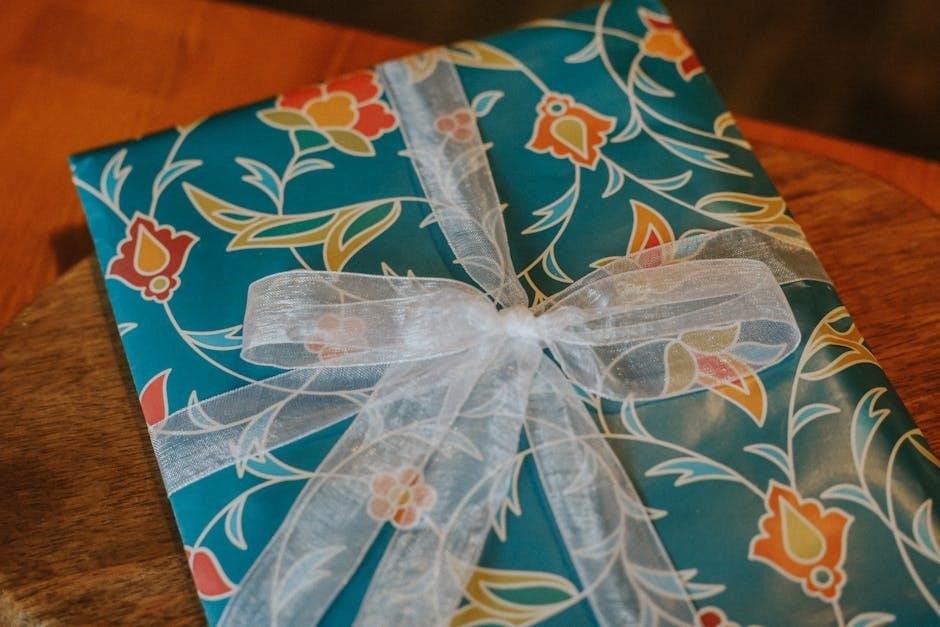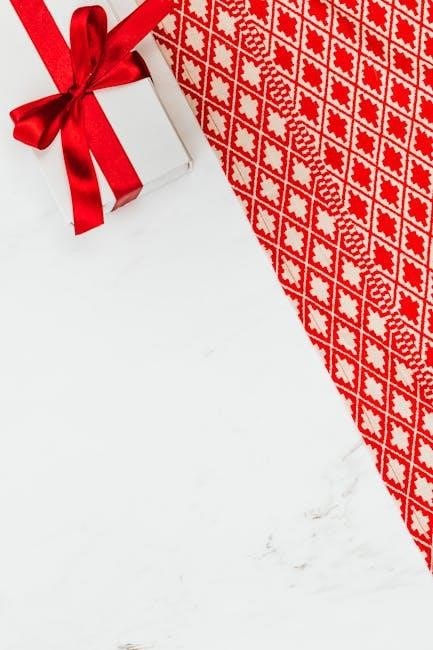A bow tie pattern PDF offers a versatile and stylish way to create custom bow ties․ Perfect for sewists of all skill levels, these free templates provide precise measurements and instructions․
With a free PDF pattern, you can craft bow ties in various styles, from classic butterfly to modern designs․ Adjust sizes and fabrics to suit any occasion or preference․
1․1 What is a Bow Tie Pattern?
A bow tie pattern is a template or guide used to cut and sew a bow tie․ Typically available as a free PDF download, it includes outlines for fabric cutting and sewing instructions․ These patterns provide precise measurements and shapes, ensuring a professional finish․ They often come in multiple sizes and styles, such as classic butterfly or modern designs․ The pattern may also include adjustable features to customize the bow tie’s length and width․ Using a bow tie pattern PDF simplifies the sewing process, making it accessible for both beginners and experienced sewists․ It’s a versatile tool for creating unique, personalized accessories․
1․2 Benefits of Using a Free PDF Pattern
Using a free PDF bow tie pattern offers numerous advantages for sewists․ It provides a cost-effective way to create custom bow ties without purchasing expensive templates․ The pattern is easily downloadable and printable, allowing you to start your project immediately․ Many free PDF patterns include multiple sizes and styles, such as classic butterfly or modern designs, giving you versatility․ They often come with adjustable features, enabling you to customize the bow tie’s length and width․ Additionally, these patterns are designed to be user-friendly, with clear instructions and measurements, making them accessible to sewists of all skill levels․ This convenience ensures a professional finish for your handmade bow ties․
Types of Bow Ties
Bow ties come in classic styles like the butterfly and batwing, as well as modern variations․ Each offers a unique look, catering to different preferences and occasions, ensuring versatility in styling․
2․1 Classic Butterfly Bow Tie
The classic butterfly bow tie is a timeless choice, known for its wide, curved ends․ Its symmetrical design makes it easy to tie and ensures a polished look for formal events․
Using a free PDF pattern, you can create this style with precision․ The pattern typically includes two main pieces, ensuring a professional finish․ It’s perfect for weddings, black-tie events, or job interviews․
Fabric choice is crucial for the butterfly bow tie․ Opt for silk or cotton to achieve a luxurious appearance․ The pattern’s clear instructions guide you through cutting and sewing for a flawless result․
2․2 Batwing Bow Tie
The batwing bow tie is a sleek, modern alternative to the classic butterfly style․ Its narrower, straight-ended design offers a streamlined look, making it ideal for slim-fit suits and contemporary outfits․
Free PDF patterns for the batwing bow tie are widely available, catering to various skill levels․ The pattern typically includes two symmetrical pieces, ensuring a balanced and professional appearance․
Popular for its versatility, the batwing bow tie can be paired with formal and semi-formal attire․ Its clean lines make it a favorite for those seeking a minimalist aesthetic while maintaining elegance․
2․3 Modern Variations
Modern bow tie variations offer fresh twists on traditional designs, catering to diverse styles and preferences․ These include wide daily, daily skinny, and asymmetrical patterns, providing flexibility for various occasions․
Free PDF patterns often feature these contemporary designs, allowing users to experiment with unique fabrics and bold patterns․ This versatility makes modern bow ties ideal for both formal events and casual wear․
By exploring these designs, users can create accessories that reflect their individuality, ensuring a perfect match for any outfit or personal aesthetic․

Materials Needed
To create a bow tie using a free PDF pattern, you’ll need fabric for the bow and neck strap, interfacing for stability, matching thread, and basic sewing notions․
3․1 Fabric Requirements
For a bow tie, choose a fabric that drapes well and matches your desired aesthetic․ Cotton, silk, or wool are popular choices due to their smooth texture and vibrant prints․ Ensure the fabric is lightweight to medium-weight to achieve a professional look․ Avoid thick or bulky fabrics, as they can make the bow tie stiff and difficult to tie․ When using a free PDF pattern, select fabrics with a subtle print or solid color to showcase the bow tie’s details․ Always pre-wash and iron the fabric before cutting to remove any shrinkage and ensure accuracy in sewing․

3․2 Interfacing and Stabilizers
Interfacing is essential for adding structure and stability to your bow tie․ Use a lightweight fusible or sew-in interfacing to prevent stretching and ensure a crisp finish․ Cut the interfacing according to the pattern pieces and apply it to the fabric before cutting out the bow tie pieces․ This step ensures the bow tie maintains its shape and lies flat when tied․ For added stability, consider using a stretchy stabilizer for the neck strap to enhance comfort and durability․ Always follow the pattern instructions for specific interfacing requirements to achieve a professional result․
3․3 Thread and Notions
When sewing a bow tie, it’s important to use high-quality thread that matches your fabric color for a seamless finish․ Choose a polyester or cotton-wrapped polyester thread for durability․ Additional notions like small needles, straight pins, and a seam ripper are essential tools․ For a professional touch, consider using a walking foot or Teflon foot on your sewing machine to handle slippery fabrics․ If your pattern includes an adjustable neck strap, you may also need sliders or a small piece of velcro․ Ensure all notions are readily available to avoid delays during the sewing process․ Proper thread and tools will ensure a polished and long-lasting bow tie․
Downloading and Printing the PDF Pattern
Locate a reliable source offering a free PDF bow tie pattern․ Download the file and ensure your printer settings are set to “Actual Size” or “100%” for accuracy․
Print the pattern on standard A4 or letter-sized paper․ Verify the scale by measuring the test square provided in the PDF to ensure proper sizing before cutting․
4․1 Finding a Reliable Source
To ensure accuracy and quality, find a trusted website offering free bow tie PDF patterns․ Popular platforms like Pinterest, Craftsy, and sewing blogs often provide well-designed templates․
- Look for patterns with clear instructions and multiple size options․
- Check for reviews or comments from other users to verify reliability․
- Ensure the pattern includes a test square to confirm proper scaling․
A good source will offer a clean, professional design, making your sewing process smoother and more enjoyable․
4․2 Printing the Pattern at Correct Scale
Printing your bow tie pattern PDF at the correct scale is crucial for accuracy․ Ensure your printer is set to 100% scale, not “fit to page,” to maintain the pattern’s proportions․
- Check for a test square or measurement guide on the pattern to verify scaling․
- Print on standard A4 or letter-sized paper for consistency․
- Avoid resizing the document, as this can distort the measurements․
Correct scaling ensures that your bow tie pieces fit together seamlessly, making the sewing process much easier and the final result professional․
4․4 Adjusting the Size if Necessary
If the standard bow tie pattern PDF doesn’t fit your needs, adjustments can be made for a custom fit․ Measure the intended wearer’s neck to determine the ideal length․

- Lengthen or shorten the neck strap pattern piece as required․
- Ensure the bow piece proportions remain balanced with the strap․
- Print a test version on paper to verify adjustments before cutting fabric․
Adjustments may also include widening or narrowing the bow for a personalized style․ Always test changes with a muslin prototype to ensure accuracy․

Cutting the Fabric
Carefully cut fabric using the PDF pattern pieces, ensuring accuracy․ Print the pattern at 100% scale for precise measurements․ Use scissors or a rotary cutter for clean edges․
5․1 Understanding the Pattern Pieces
Most bow tie PDF patterns include two main pieces: Piece A for the bow and Piece B for the neck strap․ Ensure the pattern is printed at 100% scale for accuracy․
- Piece A typically consists of two symmetrical bow shapes․
- Piece B includes the neck strap with adjustable Velcro or sliders․
Some patterns may also include interfacing templates for stability․ Always check for seam allowances and symmetry before cutting to ensure a professional finish․
5․2 Cutting Techniques for Accuracy
To ensure precision, use sharp tools like rotary cutters or scissors․ Fold fabric symmetrically and cut both layers at once for matching pieces․ Place the pattern on the fabric, aligning grain lines for stability․
- Use a ruler or cutting mat for straight edges․
- Pin the pattern securely to prevent shifting during cutting․
- Handle delicate fabrics gently to avoid stretching․
Accurate cuts are crucial for a professional finish, so double-check measurements before cutting․ This step lays the foundation for a well-made bow tie․
5․3 Using Interfacing Effectively

Interfacing is crucial for stabilizing the fabric and maintaining the bow tie’s structure․ Cut the interfacing pieces according to the pattern, ensuring they match the fabric pieces exactly․ Place the interfacing on the wrong side of the fabric, aligning edges carefully․ Fuse it using a hot iron with steam, following the manufacturer’s instructions for temperature and pressing time․
- Use a light-handled iron to avoid distorting the fabric․
- Ensure the interfacing is centered for even distribution․
- Allow the interfacing to cool before handling to set the adhesive properly․
Proper interfacing ensures a crisp, professional finish and prevents the bow tie from stretching out of shape․

Sewing the Bow Tie
Sew the bow piece, ensuring precise alignment and straight stitches․ Construct the neck strap separately, then assemble the bow tie by attaching the bow to the strap․
6․1 Sewing the Bow Piece
Sewing the bow piece begins with placing the two fabric pieces right sides together․ Align the edges carefully and pin to secure․ Sew along the curved edges, leaving a small opening for turning․ Trim the seam allowance to reduce bulk and ensure a smooth finish․ Turn the bow right side out and press with an iron to create a crisp shape․ Topstitch along the edges for a professional look․ This step is crucial for achieving a symmetrical and polished bow that will be the centerpiece of your tie․
6․2 Constructing the Neck Strap
Constructing the neck strap involves cutting two rectangular fabric pieces and one interfacing piece․ Place the fabric pieces right sides together, layering the interfacing in between․ Sew along the length, leaving a small opening to turn the strap right side out․ Carefully press the seams to ensure a smooth finish․ Fold the raw edges under and topstitch for a polished look․ Attach the adjustable slider to one end, ensuring it is secure․ This step ensures the bow tie is adjustable and comfortable to wear, completing the functional part of the accessory before assembling it with the bow piece․

6․3 Turning and Pressing the Pieces
After sewing, carefully turn the bow and neck strap pieces right side out through the small opening․ Use a blunt object like a chopstick to gently push out the corners for crisp edges․ Press the seams with a hot iron to flatten them, ensuring the fabric lies smooth․ Fold the raw edges of the opening under and press again to create a clean finish․ This step is crucial for achieving a professional look and ensuring the bow tie drapes properly; Proper pressing makes the pieces easier to handle during assembly and ensures a polished final product․ Pay attention to the bow’s curves for a natural shape․
6․4 Assembling the Bow Tie
Once the pieces are turned and pressed, align the bow and neck strap according to the pattern instructions․ Attach the bow to the neck strap by folding the raw edges under and securing with a few hand stitches․ Ensure the bow is centered and evenly spaced for a balanced look․ Use a needle and thread to sew the bow in place, making sure the stitches are tight but invisible․ Adjust the bow tie to ensure symmetry and that the ends align properly․ Finally, tie the adjustable strap to your desired length, ensuring a comfortable and secure fit․ This step completes the bow tie, ready for styling․

Adding the Final Touches
Add a professional finish with topstitching along the edges․ Tuck loose threads and ensure a crisp, polished look․ Optional adjustments include tightening stitches or realigning the bow for symmetry․
7․1 Topstitching for a Professional Finish
Topstitching is a crucial step to achieve a polished bow tie․ Using a contrasting thread, sew along the edges of the bow and neck strap․ This not only enhances the design but also reinforces the seams․ Ensure your stitches are consistent and evenly spaced for a professional look․ If your fabric is prone to fraying, consider increasing the stitch density․ Topstitching adds durability and a refined aesthetic, making your handmade bow tie stand out․ Pay attention to corners and curves, as these areas require precise stitching․ The result is a crisp, tailored finish that elevates your creation to a bespoke level․
7․2 Optional Adjustments
Once the bow tie is assembled, consider optional adjustments for a personalized touch․ Shorten or lengthen the neck strap to fit individual preferences․ Adjust the bow’s fullness by tweaking the gathering stitches․ For a stiffer bow, add more interfacing, or reduce it for a softer look․ Customize the ends by rounding or angling them for a unique style․ Embellishments like embroidery or appliques can add character․ Experiment with fabric choices, such as silk for a formal look or cotton for a casual vibe․ These small tweaks allow you to tailor the bow tie to your taste or the occasion, ensuring a one-of-a-kind accessory․

Styling Your Bow Tie
A well-crafted bow tie elevates any outfit․ Choose patterns and colors that complement your suit, shirt, and personal style for a polished, sophisticated look at events or formal gatherings․
8․1 Choosing the Right Occasion
A bow tie is perfect for formal events like weddings, black-tie gatherings, or galas․ It also adds a stylish touch to less formal settings, such as themed parties or unique celebrations․
For weddings, opt for classic patterns like silk or satin to match the elegance of the event․ For more casual occasions, consider bold colors or whimsical designs to stand out․ The versatility of bow ties makes them suitable for various events, allowing you to express your personality while maintaining a polished look․ Use the free PDF pattern to craft a bow tie that complements the theme and adds a personal touch to your outfit․ This ensures your accessory is both stylish and memorable․
8․2 Tips for Tying the Perfect Bow
Tying a bow tie perfectly requires patience and practice․ Start by facing a mirror and place the bow tie around your neck with the ends hanging evenly․ Cross the right side over the left, forming an “X” shape, then loop the right side behind and through the neck strap to create the first bunny ear․
Ensure both sides are symmetrical and adjust as needed․ Tighten the knot gently around the neck for a snug fit․ For a polished look, tuck the bow tie ends into your shirt and center the bow․ Practice makes perfect, so don’t hesitate to retry until it feels natural․ These tips will help you master the classic bow tie look, complementing your handmade bow tie crafted from a free PDF pattern․
Free Resources and Tutorials
Explore free bow tie pattern PDFs and tutorials online․ Websites offer downloadable templates and step-by-step guides to help you create custom bow ties with ease and precision․
9․1 Recommended Websites for Patterns
Several websites offer free bow tie pattern PDFs and tutorials․ Pinterest provides inspiration and direct links to downloadable templates․ Craft blogs like Sewing Parts Online and DIY Fashion offer step-by-step guides and customizable patterns․ Websites such as Craftsy and Etsy often feature free or affordable bow tie templates in various styles․ Additionally, platforms like Free Sewing Patterns and Sew Over It share detailed instructions and printable PDFs․ These resources cater to all skill levels, ensuring you can find the perfect pattern to match your fabric and occasion․ Always verify the size and style before downloading to ensure it suits your needs․
9․2 Video Tutorials for Beginners
Video tutorials are an excellent resource for mastering the art of sewing a bow tie․ YouTube channels like Sewing With Knits and DIY Sewing Tutorials offer step-by-step guides specifically designed for beginners․ These videos cover everything from downloading and printing the PDF pattern to cutting fabric and sewing the final pieces․ Craftsy and Pinterest also feature detailed video instructions, making it easy to follow along․ Many tutorials emphasize basic techniques, such as aligning fabric and using interfacing effectively․ Perfect for visual learners, these videos provide a hands-on approach to creating a professional-looking bow tie․ Pause, rewind, and rewatch sections as needed to ensure accuracy and confidence in your sewing skills․
Troubleshooting Common Mistakes
Troubleshooting common mistakes when using a bow tie pattern PDF involves ensuring correct printing scale, choosing suitable fabric, and precise sewing․ Avoid errors by double-checking pattern alignment and adjusting sizes as needed for a polished finish․
10․1 Fabric Choice Issues
Choosing the wrong fabric is a common mistake when using a bow tie pattern PDF․ Selecting fabrics that are too thick or stiff can make the bow tie difficult to shape and tie properly․ Similarly, overly thin or stretchy fabrics may not hold the structure well, leading to a sloppy appearance․ It’s important to opt for medium-weight fabrics like silk, cotton, or wool, which provide the right balance of stability and flexibility․ Ensuring the fabric has a smooth texture will also help achieve a professional-looking finish․ Always pre-wash and iron the fabric before cutting to avoid unexpected shrinkage or wrinkles during sewing․ Proper fabric selection is key to achieving a crisp, elegant bow tie․
10․2 Sewing Error Solutions
Common sewing errors when using a bow tie pattern PDF include incorrect seam allowances or misaligned pieces․ To fix this, backstitch at the beginning and end of seams for reinforcement․ If the bow tie pieces don’t match up, check your fabric alignment and ensure accurate cutting․ For puckering or uneven stitching, use a walking foot or Teflon foot on your sewing machine․ Additionally, pressing seams as you go can help maintain shape and prevent distortion․ If the bow tie feels too tight or loose, adjust the neck strap length before final assembly․ Proper pinning and slow, steady sewing will yield professional results․ Always double-check your pattern instructions for specific guidance․
Creating a bow tie using a free PDF pattern is a fun and rewarding project․ With patience and practice, you can craft unique, stylish accessories for any occasion․
11․1 Summary of Key Points
Using a free bow tie pattern PDF simplifies the sewing process, offering precise measurements and guidance for various styles․ The template ensures accuracy, making it ideal for beginners and experienced sewists alike․ Key steps include downloading the pattern, cutting fabric accurately, and sewing with attention to detail․ Optional adjustments allow customization, ensuring a perfect fit and personalized design․ The availability of free resources and tutorials further enhances the learning experience, enabling anyone to create professional-looking bow ties at home․ This approach fosters creativity and confidence in DIY fashion projects, making bow tie sewing accessible and enjoyable for all skill levels․
11․2 Encouragement to Start Sewing
Embrace the creativity of sewing with a free bow tie pattern PDF! This project is a great way to begin your sewing journey, offering a fun and rewarding experience․ Whether you’re crafting for yourself or as a gift, the process is both therapeutic and fulfilling․ With easy-to-follow instructions and versatile designs, you can create unique bow ties that reflect your personal style․ Don’t hesitate to experiment with fabrics and styles—every stitch is a step toward mastering a new skill․ Start sewing today and discover the joy of creating something truly special with your own hands!
